Thinzar Hein: Tragedy strikes again, as the bringers of death put the savers of lives in their sights

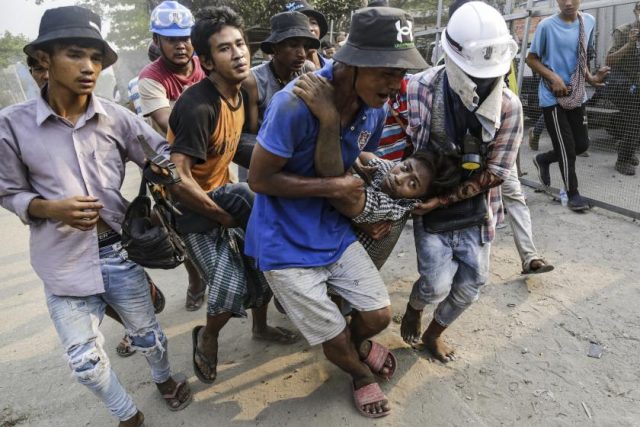
An injured demonstrator is carried to receive medical attention during a protest against the military coup in Hlaingthaya (Hlaing Tharyar) Township, outskirts of Yangon on March 14 (EPA-EFE)
By Myanmar Now
Thinzar Hein and her friend Aye Aye were resting under a tree after treating three injured protesters. They could hear gunshots nearby and knew they would have to cut their break short. There would soon be others in need of their assistance.
This was how they lived now—trying to find a moment’s peace in all the mayhem, keeping their heads down as the bullets flew past, saving as many lives as they could.
They were both members of an emergency medical team in Monywa, the largest city in Sagaing region. Thinzar Hein, who was a second-year nursing student, had left her home against her parents’ wishes to join the movement against military rule. She had met Aye Aye, who at 23 was three years older than her, at an anti-coup rally in February.
They had spent many hours together, tending to the wounded or collecting the bodies of the dead. They knew they were risking their lives every time they entered one of the killing zones, where soldiers shot at anything that moved.
Thinzar Hein wrote on her social media page that she didn’t want anybody to take the same risk for her sake.
“Don’t bother with my body if I fall. Just help the others,” she wrote in a March 14 post.
But these are not the words Aye Aye (whose name has been changed for her security) will remember her friend by. “Sister, I don’t want food. I just want a cold drink,” she said, moments before soldiers suddenly appeared and shot her in the head.
Another bullet went through Aye Aye’s shoulder as she sat next to her friend, whose now lifeless body slumped forward and fell into the street. There was no way to save her amid the hail of bullets that just kept coming, she said.
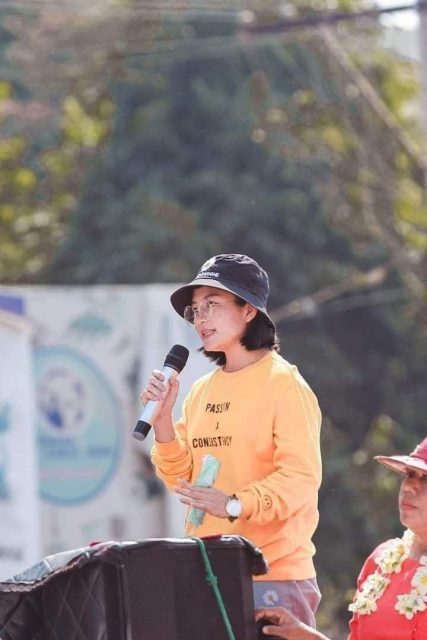
Thinzar Hein gives a speech to to a crowd of protesters in Monywa on February 22
Taking a stand
Thinzar Hein’s parents told her not to go, but she went anyway.
Her father was reportedly a member of the Union Solidarity and Development Party, the army-backed party that had suffered a humiliating defeat in last year’s election. He disapproved of the protests against the February 1 coup, but she was determined to join others who opposed the regime. She left home because she wanted to stand on her own two feet.
She said as much during a speech that she delivered in front of Monywa’s clock tower on February 22, the day of the “five twos” (22/2/2021) general strike that marked the start of an effort to turn weeks of protests around the country into a nationwide uprising.
By this time, public employees had already launched the Civil Disobedience Movement (CDM) that aimed to cripple the regime’s capacity to rule. Thinzar Hein said she had lost respect for teachers at her nursing school who did not join the CDM.
“You should be ashamed if you can’t say in the future that you were a part of the revolution,” she said.
Aye Aye heard this speech and was impressed. But their friendship began when Thinzar Hein started giving her rides to the protests on her motorcycle.
Since Thinzar Hein had nowhere to live after leaving her parent’s home, Aye Aye let her stay at her hostel. That’s when Thinzar Hein taught her how to provide basic emergency medical care, she said.
At first it was just the two of them who went wherever they were needed to help the wounded. That meant anywhere they could hear the sound of gunshots that had become a feature of everyday life in Monywa and cities all over Myanmar since the coup.
Then, on March 3, they saw a man who had been shot in the leg die right before their eyes. Thinzar Hein knew he might have been saved if they had been better prepared to deal with his injuries. And so they decided to form an emergency medical team, raising funds to buy proper medical equipment through their network of fellow protesters.
Facing death
Thinzar Hein used her formal medical training to teach others how to tend to the wounded. In a small room, she instructed 20 people at a time in the first-aid techniques that would make the difference between life and death for victims of a regime intent on terrorizing the country into submission.
“She was very passionate,” Aye Aye said of her friend, recalling Thinzar Hein’s reaction to the death of the man who had been shot in the leg.
“She said she knew there were going to be more shootings,” she added, speaking to Myanmar Now soon after undergoing surgery on her shoulder.
That certainty fuelled Thinzar Hein’s determination to be prepared for any eventuality, including her own death.
In her final message to friends and family, she asked for the forgiveness of those she would have to leave behind if she didn’t survive her dangerous mission.
“I hope my loved ones will forgive me for embarking on a path that doesn’t guarantee a safe return,” she wrote on her Facebook page two days before she was murdered by Myanmar’s terrorist junta.
While regime forces go on a state-sanctioned killing spree, medics and other volunteers around the country continue to put their own lives on the line in the hope that they can save even one injured civilian.
Even when they know there is no one left to save, they return to protest sites day after day to collect the bodies of the dead before they can be taken away and disposed of by their killers.
After a night of bloodshed, people like Thinzar Hein will arrive at a scene of carnage before dawn to attend to both the living and the dead. If they are caught off-guard, they, too, will become casualties of the regime’s war on human decency.
“This is not okay. Even in international wars, medics are not targeted. But here, they’re worried their actions will be exposed, and so they fire at everyone,” said one doctor in Mandalay, describing the behaviour of the junta’s forces.
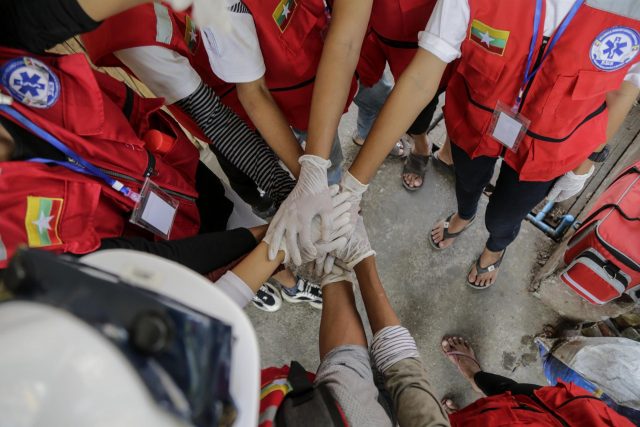
Dying in agony
Often, medical volunteers will wait for hours for soldiers to leave, knowing that that many victims won’t live long enough to be rescued in the morning.
These are agonizing hours, when they have to listen to people in need of immediate attention moaning in pain. In Monywa, one team spent three hours like this, blocked by soldiers who stood ready to shoot them on sight, until the victim finally fell silent. By the time they were able to reach him, the 30-year-old man had bled to death.
“There was a big cement wall we used as cover, but we couldn’t get to him. We could only pick him up after he was dead,” said a member of the team that attempted to rescue the man.
“Every time we are forced to watch someone die from nearby, it hurts. Every second is important for a bleeding patient,” said the doctor in Mandalay, where many volunteers have had similar experiences.
A member of one rescue team in Myanmar’s second-largest city said he once spent six hours in this situation, as multiple gunshot victims slowly died from their injuries.
“The worst time was in Aung Pin Lal, where they even shot at ambulances and medics had to run for their lives, leaving patients behind,” he said. “Some died of blood loss, and there was nothing we could do about it. It was just a really sad sight.”
Another member of the team was killed at the same time, and his body was never recovered, he added.
Often, he said, family members of people who have gone missing will turn up at emergency clinics in tears, hoping to find them still alive. In many cases, however, the rescue workers can’t even manage to bring back their dead bodies.
And then there are those who somehow escape on their own, but don’t dare seek treatment because of the heavy military presence. Only when their condition becomes truly dire will they come out of hiding.
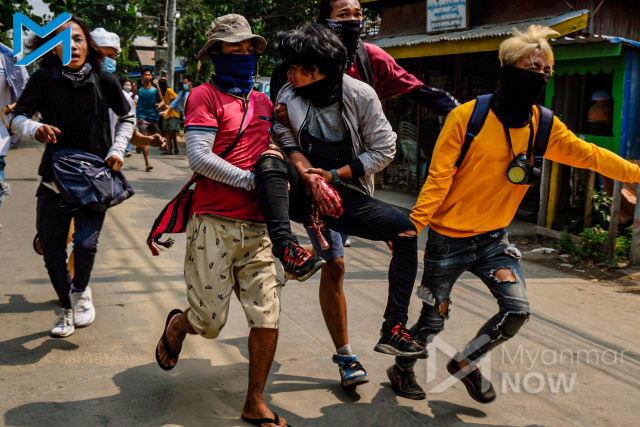
Protesters carry a person to safety after they were shot and wounded by regime troops in Yangon’s Thaketa township on March 29 (Myanmar Now)
Keeping the fight alive
It’s unclear how many medical workers the regime has murdered so far. Many, like those trained by Thinzar Hein, were not professionals, but simply dedicated volunteers who had acquired very basic, but still life-saving, skills.
What is clear, however, is that the junta has singled out rescue workers for especially brutal treatment in its all-out war against Myanmar’s civilian population.
This fact has been evident since March 3, when CCTV cameras captured images of four medics in Yangon’s North Okkalapa township being viciously beaten by soldiers and police for “encouraging” protesters to defy the regime.
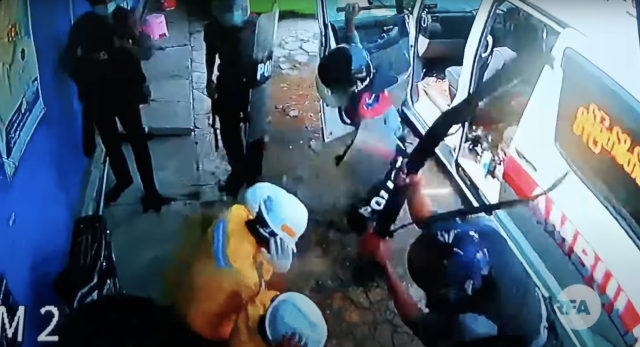
CCTV cameras captured images of four medics in Yangon’s North Okkalapa township being viciously beaten by soldiers and police on March 3
The four medics—Kyaw Min Lwin, Thant Zin Oo, Min Oo and Soe Htet Aung—were later transferred to Yangon’s notorious Insein prison, from which they were finally released, along with 700 other prisoners, on March 24.
Wai Phyo Aung, a young medic who had volunteered in Hlaing Tharyar two weeks later, was not so lucky. When the township in western Yangon came under assault on March 14, he became one of 58 people killed by regime forces over the next five days.
At around the same time, on March 15, soldiers fired on an ambulance in Myingyan, a city in Mandalay region, according to a local doctor who witnessed the incident.
“They started shooting at the ambulance when it went to pick up some dead bodies,” the doctor said. Photos seen by Myanmar Now confirmed his account, which was similar to reports received from other parts of the country.
When Thinzar Hein was shot, her expressed wish to be abandoned to avoid further death was ignored by another member of her team, who crawled to her body under heavy fire and rolled it to a side street so that he could pick it up and carry it to a clinic, where she was declared dead on arrival.
Like others inspired by Thinzar Hein’s example, her friend Aye Aye vowed to continue her work as soon as she recovered from her injuries.
“I will keep fighting,” she said. “I will always be a part of her team.”
Original Post: Myanmar Now

